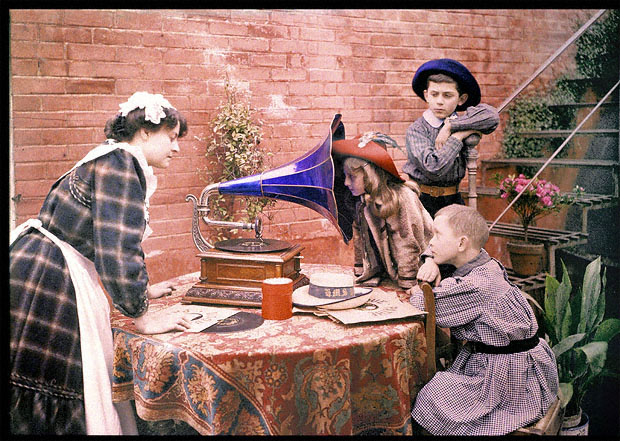Le Phonographe – Autochrome by Jean-Baptiste Tournassoud -American Museum of Photography
|
|
|
|
|
|
Tournassoud was a career officer in the French Army. He produced hundreds of striking Autochromes depicting French troops during World War I , and towards the end of the war (1918) he was named Managing Director of the Army’s division of Photographic and Cinematographic Services. Tournassoud’s involvement with the Autochrome goes back to the very earliest days of the process. He was a close friend of inventors Louis and Auguste Lumiere, referring to them as “my guides, who led me for many years in the artistic way.” This friendship enabled Tournassoud to have access to Autochrome plates long before they were available to the public, and he became one of the great masters of early color photography. “Le Phonographe” is a genre scene straight out of La Belle Epoque, the golden years from the late 1800s until the outbreak of World War I. Echoing the paintings of family life among the affluent that were popular at the time, Tournassoud has enlisted his wife, Georgette, and his 10-year old daughter Juliette to serve as models. (The two boys have not been identified.) Everything has been carefully arranged for the camera, and to take advantage of the capabilities of the Autochrome process. Georgette appears to be playing the role of a housekeeper or governess, using the new phonograph to entertain her young charges. Even the clothing has been deliberately selected, from the red and blue hats to the black-and-white checked dress of the boy seated at the table– a subtle reminder, perhaps, of what the rest of the picture might be like without color. The tablecloth adds muted colors to the scene, and the metallic blue of the phonograph horn stands out in dazzling relief from the red bricks behind it. Depending on the light conditions and the camera, all of the participants may have been required to hold their expressions and poses for several seconds– yet everyone seems comfortable, engaged, and unposed. Tournassoud has not just captured a slice of domestic life, he has created a scene, arranging every detail to tell us a story– and a colorful story, at that. |
|
| < CLICK HERE for a custom-made poster print of “Le Phonographe” > |
| |
|
Copyright © MMVII The American Photography Museum, Inc. – – – – Image: Wm. B. Becker Collection, © AAJBTAmerican Museum of Photography and the logo are Service Marks of The American Photography Museum, Inc.





